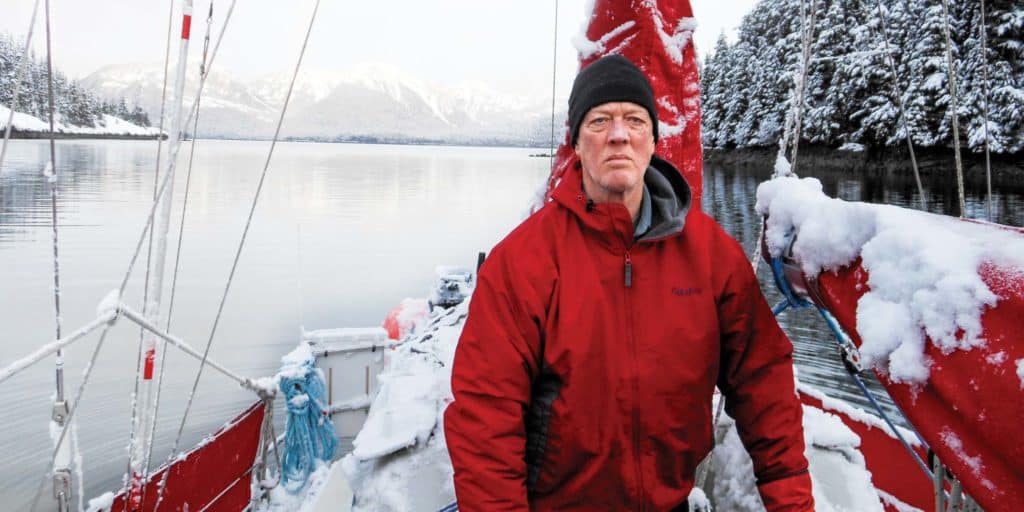
An early March gale had raged all night, snow mixed with rain sweeping down from the heavily forested peaks above my anchorage at Naked Island, in the middle of Alaska’s Prince William Sound. These were not unusual conditions for this time of year at nearly 61 degrees north, particularly so close to the equinox. In fact, I’d experienced the same in this region many times during the annual early spring herring fishery. I’d weathered spring storms in an anchorage just a few miles away, where George Vancouver’s HMS Discovery had been torn from her moorings in 1794, losing her precious anchors in the process. Vancouver had been forced to weather the storm at sea.
In more than 35 years as a nearly full-time mariner — as both a fisherman and a cruising sailor — I’d only found myself dragging anchor three times. I clearly remember each occasion. The first was about the same time of year, in the same harbor that had been Vancouver’s undoing. My 91-foot Quin Delta lay in Port Chalmers, on Alaska’s Montague Island, with my other fishing boat, the 66-foot Triton, secured along the port side. On the starboard side, a modern 52-foot Alaskan seine-fishing boat was secured, its crew making repairs to their net as we waited out the storm and anticipated the arrival of great schools of herring.
Keeping a close watch while I swapped sea stories with Dave from Triton, it became apparent that even Quin‘s 1,000-pound navy anchor could not continue to hold the entire flotilla, and we were ever so slowly dragging astern. We said our goodbyes, let go lines from both of the smaller boats and watched them move in closer to shore to find their own shelter. That’s all it took. Relieved of the loads imposed by the other two boats, we were once again secure.
The other two occasions were both in the mouth of the Naknek River in Bristol Bay, in the southeastern part of the Bering Sea. Bristol Bay, named by Capt. James Cook for the English port of the same name, is annually the locus of one of the world’s most important fisheries. Every season for millennia, tens of millions of sockeye salmon (oncorhynchus nerka) return to their natal spawning streams flowing from lakes in the great mountain range to the east.
Bristol Bay experiences one of the most extreme tidal exchanges anywhere in the world. That fact of nature was actually a crucial element of my business plan. Quin Delta had been specially designed to be very shallow of draft, while at the same time a superb sea boat capable of traveling throughout the enormous range of Alaska’s coastline in order to ply her trade. In Bristol Bay, our job would be to offload tons of salmon from smaller catcher boats, immerse them immediately in refrigerated sea water, then transport this product to waiting ships or shore-based processing plants. Because of the extreme tides, access to these shore plants could be very difficult. That’s where Quin Delta excelled, and that was part of my stock in trade.
The company for which we were providing these tendering services had assigned us duty in the mouth of the Naknek, just inside the regulatory line that defined the legal fishing area. This made us readily available to the smaller catcher boats, allowing them to quickly offload and return to fishing.
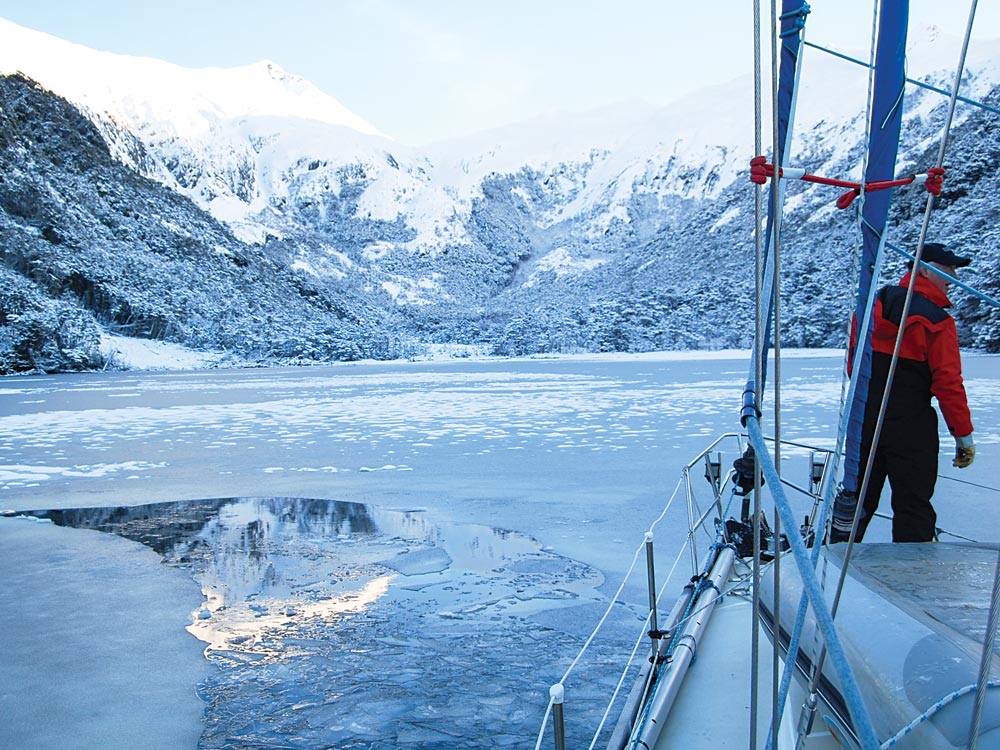
The enormous tidal exchange of the bay meant that the lower reaches of rivers like the Naknek experienced very powerful reversing currents each tide cycle. As the tidal current reversed direction and gained velocity, it dislodged Quin‘s massive anchor and we dragged a very short distance. After the second such episode, we simply got into the habit of drumming up the 7⁄8-inch wire rope and 1 1⁄8-inch stud-link chain anchor rode onto the massive windlass on the foredeck, moving ahead a few yards, then laying out the ground tackle once again, but now in the direction appropriate for the force of the tidal current.
As was always our practice, not only during the storm in Port Chalmers or in the currents of the Naknek River, we’d lay out a very generous scope of rode, then begin to back down the nearly 200 tons of boat and product. As the wire came tight, I taught my crew to hold it with an ungloved hand, literally feeling the wire begin to “sing” to them, and to interpret its vibrations like a train robber, his ear to the rail.
If the anchor was skipping along the bottom, they would feel each rock it passed over and signal me with an up and down motion of their outstretched arm. Once it gained hold they’d nod their head, signifying “yes,” then I’d add power progressively, both engines in reverse. If the anchor moved at all, they could feel it through the wire, and they’d repeat the arm signal. But if it held, they would continue to nod their head as more and more power was applied, until the thrust of both main engines coursed through the hull, foam boiling beneath the stern. If the wire still sang the correct tune as it took up the strain, the crew would make a thumb’s-up signal. Only then would I consider the boat secured. As I brought the throttles back down and shifted into neutral, the crew on the foredeck would set the dog on the windlass and secure the brake before returning to the comfort of the warm galley.
We did this procedure hundreds, no thousands, of times over the decades. Only on those three occasions did we ever drag anchor, notwithstanding boats secured alongside; storms; tides; even, on a few occasions, football-field-size sheets of ice drifting down on the bows, riding up the wire rope until finally splitting apart and passing down each side. When our hands had told us that we were made fast to the bottom of the sea, we were confident that we were indeed secure. Even so, we still posted an anchor watch that relied on human eyeballs as well as electronic devices. It’s safe to say we had anchoring down.
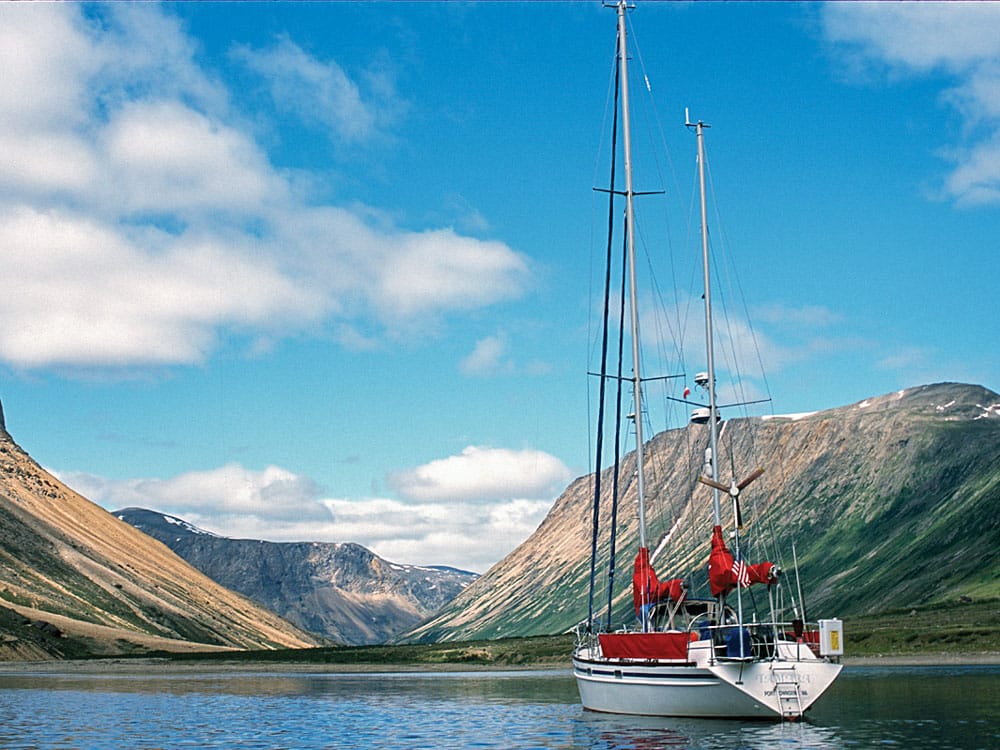
At the start of the new millennium, I got a surprise opportunity to realize the long-held dream of cruising under sail, and sold the fishing boats to voyage aboard my custom 44-foot steel ketch, Tamara. But I came away with those previous lessons learned, and did my best to apply them to our pursuit of personal adventure.
In the decade and a half that my partner, Nancy Krill, and I have cruised Tamara, we have followed pretty much the same procedure. Unlike the wire rope on Quin Delta, Tamara‘s anchor rode, like most well-found long-distance cruisers, is all chain. Though it doesn’t “sing” under tension in the same way as wire, the chain nevertheless transmits a lot of information about the bottom that the haptic senses translate in the brain. I’d hold my hand around the chain, and as Nancy progressively added power in reverse, we’d use the same signals. We added a few more just to satisfy my own sense of ultimate responsibility. Since I was not at the helm and couldn’t judge the amount of power applied, our signals grew to include my upwardly extended and twirling index finger to signal that she could apply more power, and then she would signal me with a down-turned palm waved horizontally to indicate half astern, then finally, an upturned thumb to signify full astern.
RELATED: Your Chain Explained: Understanding Anchor Chain
Cruising from the Arctic to the Antarctic and on to Alaska, Nancy and I have been forced to advance this basic technique to suit local conditions. We learned which bottom strata afforded the best holding, and we’d search out that material as indicated on the chart. I’d make notes in the log of the material that came up on the anchor or in the chain, and correlate that to the ease — or better yet, the difficulty — with which the anchor broke out once we had shortened up. Our personal favorite became clay with some sand and firm mud mixed in, the way a good brick is cast. At times, we’d look for entering streams that might have carried down suitable material. And we learned that the best shelter from the wind was seldom offered by high terrain, but more often by an even, saddle-shaped land feature of more moderate elevation that wouldn’t generate violent williwaws, offering instead more consistent (though sometimes higher) winds.
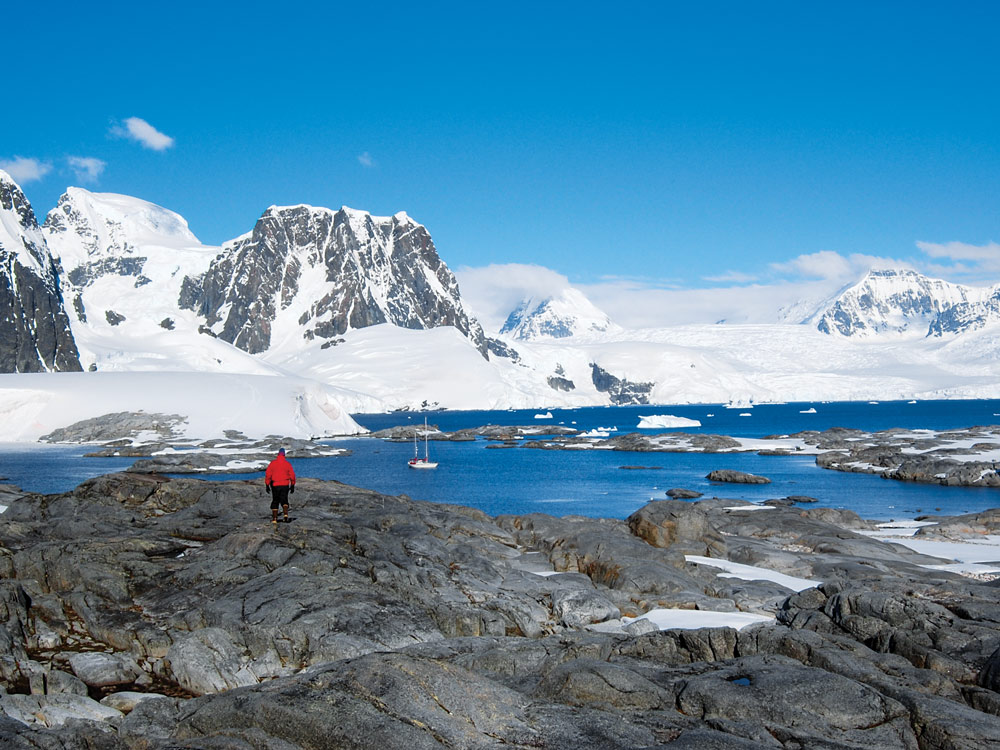
In 15 years and tens upon tens of thousands of miles, anchoring hundreds of times in the most challenging of cruising grounds in both Northern and Southern hemispheres, once we had felt the anchor grab hold and survive our demanding mechanical stress test, Tamara had never, not once, dragged anchor. There had been occasions in Labrador, near the Hudson Strait, in Antarctica, Patagonia and on the Alaska Peninsula when violent katabatic winds laid Tamara completely over on her beam ends, sailing back and forth on her chain, the surface of the anchorage boiled into a tempest even close in to the shore, but not once did we fail to hold our position.
Until that wet and cold wintry day at Naked Island.
It was just an ordinary gale, winds of 35 knots or so. Nothing compared to some of the full storms that often bring hurricane-strength winds to this region, particularly near the equinox. Once anchored, I’d secured the all-chain rode with a hook shackled to stout Spectra line. Without Nancy at the helm — I was alone on my annual late-winter solo cruise in the sound — I had to make my way back and forth from the bow to the cockpit a number of times as I backed down while applying progressively more power. After the 88-pound Delta anchor felt well-bedded, as indicated by my grasp of the 3⁄8-inch chain, I throttled down Tamara‘s powerful main engine, squared away the deck, fitted a nylon snubber over the bow to the chain, then shut down the engine and most of the electronic equipment except one of the two Furuno GP-32 full-featured GPS units aboard.
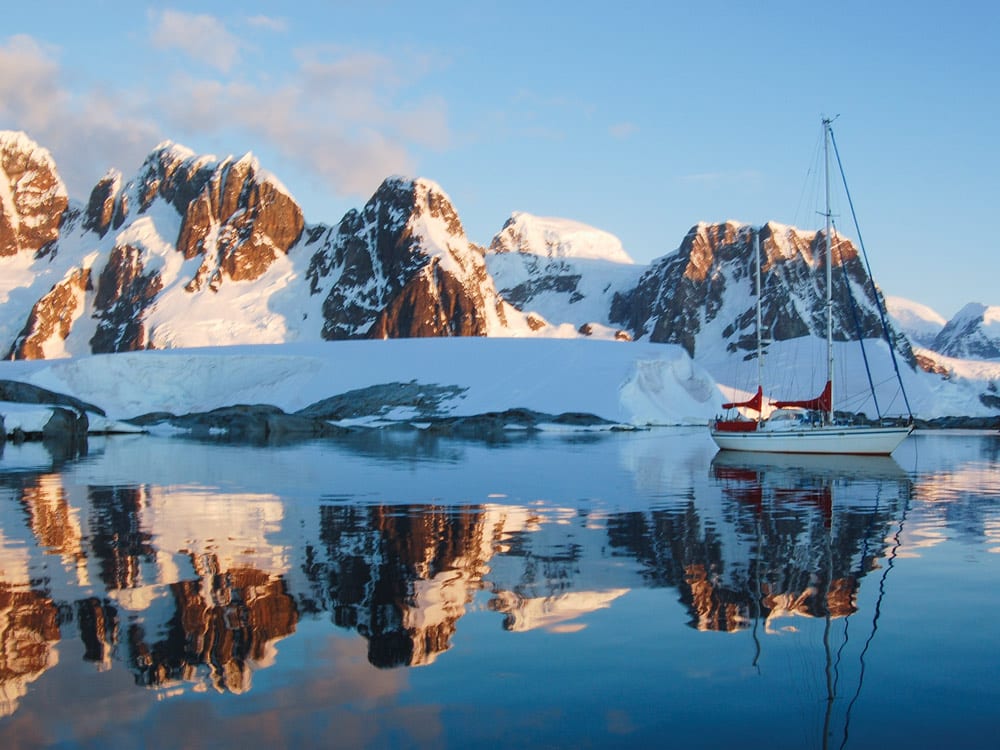
The GPS, in addition to supplying data to a computer chart plotter as well as radio communications and automatic identification systems, has its own stand-alone display. Included in these options is a small track plotter with an electronic alarm function. After marking our position, I set the anchor alarm to annunciate a warning should Tamara move more than .03 nautical miles from the designated spot. Why that particular distance value? I’d anchored in 6 fathoms and laid out about 30 fathoms of chain. One one-hundredth of a nautical mile is about 60 feet. Thirty fathoms of chain would be just about .03 mile. So a .03-mile setting would permit Tamara to swing a considerable distance side to side on her chain without triggering the alarm, but should we begin to move astern, beyond the arc of that swing, the alarm would sound almost immediately.
Periodically throughout the evening I glanced at the GPS to check our position. The plot on the display showed that indeed we would transverse a wide arc as we swung, but even with the swing we had never gone more than .02 miles — 120 feet — from the initial position. Assured that we were secure, I got a good night’s rest.
The next morning, although the wind was up, it still was not so high as to trigger the alarm I’d also set on the wind instrument. The GPS indicated that we were still well within the .02-mile arc of swing.
At noon, the anchor alarm sounded. The wind had remained about the same — strong but not alarmingly so — so I expected to note a directional shift that would explain the alarm when I consulted the GPS display. But we were still oriented in the same direction, swinging the same arc. A glance through the Lexan companionway drop board confirmed the display. Then I noted that the GPS now indicated .04 miles, then .05 miles from the initial position.
Tamara was dragging her anchor!
Immediately, I climbed the companionway ladder and cranked the starter on the 90 hp diesel engine. It started instantly. The ambient water temperature, although a few degrees higher than normal, was still only 38 degrees. In the well-insulated engine compartment, the temperature seldom exceeds the water temperature unless the engine or generator has been operating, so it is my practice to run the generator twice per day not only to keep all systems fully charged but also to maintain a good start-up temperature should the main engine be needed. Preparation, one small part of seamanship, had paid its dividend.
But then I broke one of my own rules of seamanship, learned and practiced over a long career: Do nothing in haste — especially when time is important. The Latin proverb festina lente, or “hurry slowly,” came to mind. Patience, perhaps the very first tenet of seamanship, was about to escape me.
Scrambling back down below in order to turn on the depth sounder and chart plotter, as well as to quickly don wet-weather gear at least suitable for a few minutes topside in wind, snow and rain, my haste resulted in me going down the ladder with my back to the treads. Of course, I knew I should always face in toward the treads, and firmly grasp both handholds, but I was thinking ahead rather than in the moment. My foot shot off the tread, I went straight down, and though I landed on both feet, the inside of one knee and the opposite elbow suffered hammerlike blows from each rung on the way down.
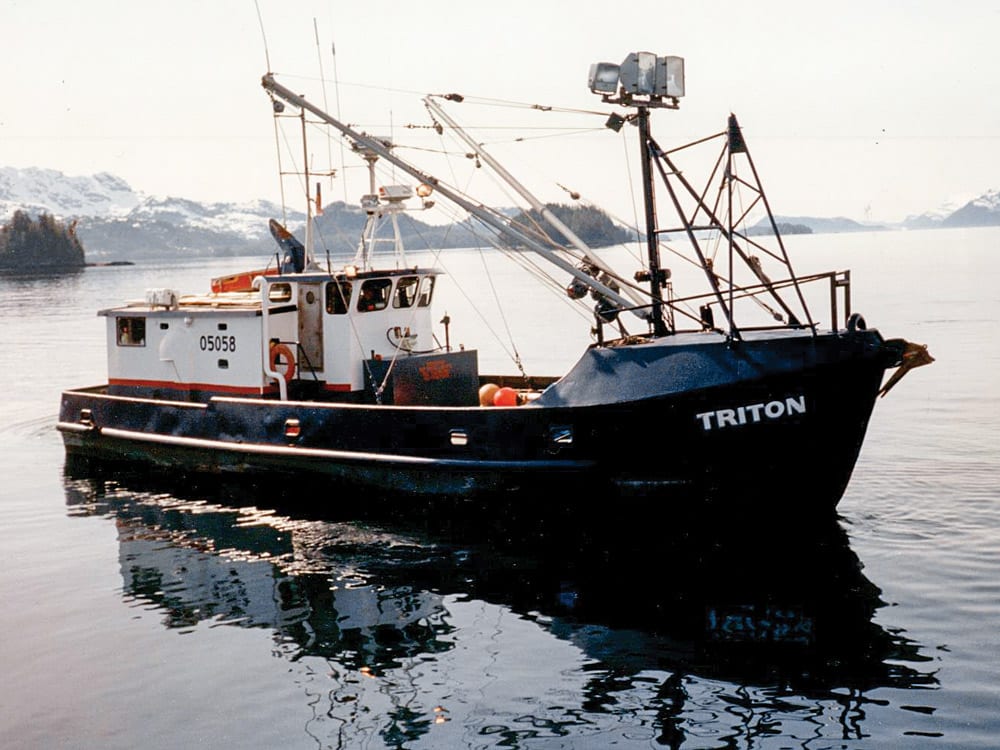
The pain was exquisite; it brought me instantly back to the present. The future would have to wait its turn. It’s true that we often learn more from making bad decisions than good ones because the consequences are less ambiguous. There certainly was nothing ambiguous about my pain!
Turning on the instruments that would give me essential information, while wriggling into hooded jacket, over-pants and fur-lined boots, I donned a PFD, grabbed a pair of fleece-lined vinyl gloves and re-climbed the ladder. We were moving rapidly now, Tamara broadside to the wind, notwithstanding the heavy anchor and chain still deployed over the bow. The ragged point of rocks protruding from the north shore of the entrance to the anchorage was coming up alarmingly fast. Though counterintuitive, the very speed dictated that now, of all times, I must act slowly and with deliberation.
Firefighters, mountain rescue personnel and avalanche responders put this concept into a simple acronym. STOP: stop, think, observe and plan. I didn’t recite this useful mantra, but sobered by my fall, I engaged in much the same calculus.
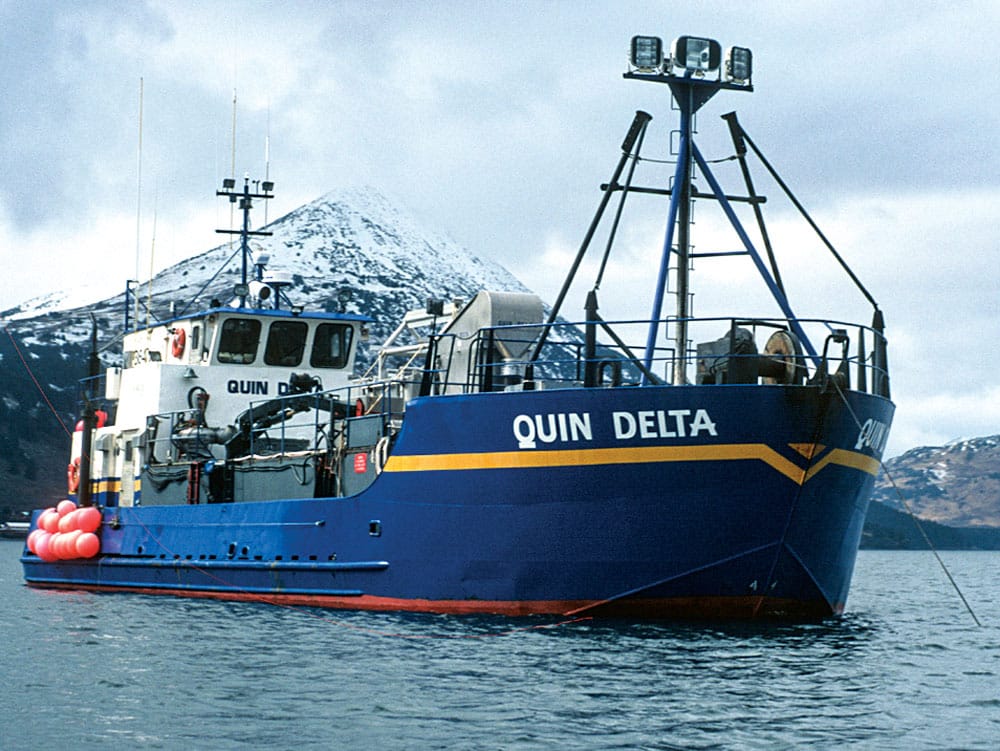
Putting the helm down, I gave a burst of power and brought Tamara‘s bow to the wind, then continued for a bit, running up on the chain. Unlike rope, the chain would sink fast and stay clear of the propeller, at least as long as I exercised good judgment. Judgment, like preparation and patience, is another of the essential elements of seamanship, and now it had become paramount.
It would be difficult, without the help of a helmsman, to bring in the heavy chain and anchor because the wind kept forcing Tamara‘s bow out of the eye of the wind, causing the chain to come in over the bow roller at a right angle. I listened carefully to the mechanical protests of the powerful windlass, then moved — this time without haste — back to the helm to repeat the burst of power and the run up the chain. Then it was back to the windlass to bring in more chain. Then back to the helm. Three or four repetitions of this cycle, and the anchor was up.
Now things followed the familiar routine. Glancing at the electronic chart, I worked Tamara close in to the lee offered by the shore, repositioning her a hundred yards or so closer in and to the north of the original position, hoping to avoid whatever bottom condition had failed me in the first attempt. The chart had no bottom strata information, and I had no notes from any previous visit, so once again I’d have to rely on touch and positioning information while setting the anchor.
Deploying even more chain than before, and backing with increasing power — all while feeling the chain and checking my bearings — I was reasonably confident that we were once again secure.
Within a few hours, the wind subsided, the sky brightened a bit and I passed a pleasant evening planning the following day’s run. I gave a good deal of thought to what might have occasioned the entire event and concluded that it could only have been due to the quality of the bottom of the seabed, but would have to wait until morning for proof.
The next day the sky had cleared, a gentle breeze from the west assured a beautiful day, and the high, snow-covered mountains around the sound shimmered in the morning light. The peaks themselves, however, served more to focus my attention on what had occurred the day before. These were heavily glaciated take-no-prisoners mountains encompassing one of the most beautiful, but least forgiving, parts of the world. They, like the sea itself, didn’t care one way or another whether I lived or died. That was entirely up to me.
Hauling back the ground tackle showed nothing unusual until the last few fathoms of chain. Inside each link was an oozing mud, “squishy,” as Nancy would say. No clay, sand or firm mud. Good enough to hold up to a point, but not up to the loads generated over time as Tamara‘s bow sailed back and forth overnight at the whim of the williwaws. That information is now underlined in red in my log.
What did I learn from the event? Nothing that I’d not long known except that long knowing something and practicing it can be two different things altogether. Ah, practice: another of those essential elements of seamanship. All that you might know is for nothing unless you put it into practice.
As an Alaskan fisherman, Mark Roye logged more than 200,000 miles at sea, more than half of them aboard his specially built 91-foot steel fishing boat, *Quin Delta. His partner, Nancy Krill, frequently served aboard as well. Tamara, whose home port is Cordova, Alaska, is a 44-foot steel ketch designed by Swedish naval architect Rolf Modigh and built in 1989. She has carried the couple more than 55,000 miles, half of it at latitudes beyond 50 degrees north and south on trips to the Arctic and Antarctic.*








